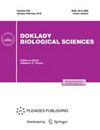北高加索中新世晚期巨熊Huracan borissiaki sp. 11 .(熊科,食肉目)(俄罗斯斯塔夫罗波尔地区)。
Q3 Agricultural and Biological Sciences
Doklady Biological Sciences
Pub Date : 2025-06-01
Epub Date: 2025-09-14
DOI:10.1134/S0012496625600198
引用次数: 0
摘要
来自俄罗斯斯塔夫罗波尔地区科斯亚基诺采石场中新世末期的一只巨熊的下颌骨被描述。下颌骨咬前窝的存在和下颊齿结构的特征(P4有后齿槽尖但没有内侧脊,M1有细长的副齿,大的后齿槽,双内齿和发达的中齿槽,M1- m2没有齿槽)可以将研究的标本归为Huracan属,并建立了一个新种,H. borissiaki。本文章由计算机程序翻译,如有差异,请以英文原文为准。
Gigantic bear Huracan borissiaki sp. nov. (Ursidae, Carnivora) from the Terminal Miocene of the Northern Caucasus (Russia, Stavropol Territory).
The mandible of a gigantic bear from the terminal Miocene of the Kosyakino quarry in the Stavropol Territory of Russia is described. The presence of a premasseteric fossa of the mandible and characteristic features in the structure of the lower cheek teeth (P4 with posterior cingulid cusp and without medial ridge, M1 with elongated paraconid, large metaconid, double entoconid and developed mesoconid, and M1-M2 without cingulids) allow to attribute the studied specimen to the genus Huracan and to erect a new species, H. borissiaki.
求助全文
通过发布文献求助,成功后即可免费获取论文全文。
去求助
来源期刊

Doklady Biological Sciences
Agricultural and Biological Sciences-Agricultural and Biological Sciences (all)
CiteScore
1.10
自引率
0.00%
发文量
66
期刊介绍:
Doklady Biological Sciences is a journal that publishes new research in biological sciences of great significance. Initially the journal was a forum of the Russian Academy of Science and published only best contributions from Russia in the form of short articles. Now the journal welcomes submissions from any country in the English or Russian language. Every manuscript must be recommended by Russian or foreign members of the Russian Academy of Sciences.
 求助内容:
求助内容: 应助结果提醒方式:
应助结果提醒方式:


